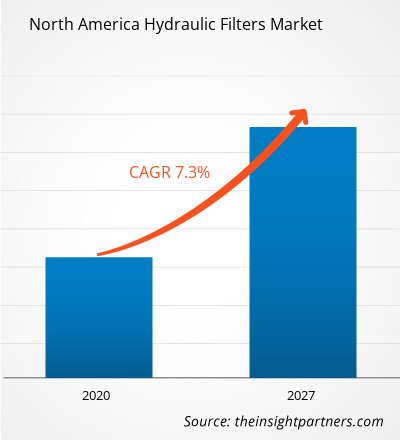The hydraulic filters market in North America is expected to grow from US$ 1194.88 million in 2019 to US$ 2089.54 million by 2027; it is estimated to grow at a CAGR of 7.3% from 2020 to 2027.
The US, Canada, and Mexico are major economies in North America. Rising digitization is boosting demand for hydraulic filter is driving the North America hydraulic filters market in a positive way. Digitization has increased the efficiency of existing machines and is expected to boost the demand for hydraulic filter in the North America hydraulic filters market in 2019 because of reliable and high quality offerings. The emergence of new market players from the North America is a new challenge for established leaders in the market. The idea of digital machinery has transformed manufacturers from 'hardware-only' providers into 'providers of' hardware, software, and services, which in turn has led to the development of new business models. These new models are used by hydraulic filter manufacturers to generate a steady stream of revenues and build a loyal client base. Digitization has paved the way for manufacturers of hydraulic filters to introduce new business models based on equipment utilization or performance. Also, integrating digital electronics with hydraulic systems provides one of the best solutions in modern control architectures in terms of high power density and hydraulic system flexibility. Moreover, with just few modifications, such electro-hydraulic components can be easily integrated with conventional systems. Similarly, hydraulic hose failure or connector leakage of hydraulic systems can be predicted using IoT technology. Thus, growing digitization is one of the major factors driving the growth of North America hydraulic filters market during the forecast period.Further, the ongoing COVID-19 is having a very devastating impact over the North America region. Presently, the US is the worst-affected country due to the COVID-19 outbreak. North America is one of the most important regions for the adoption and growth of new technologies owing to favorable government policies to boost innovation, the presence of a high-tech companies, and high purchasing power, especially in developed countries such as the US and Canada. The US is the worst-hit country in North America, with thousands of infected individuals facing severe health conditions across the country. The continuous growth of infected individuals had led the government to impose lockdown across the nation’s borders in last few months. As a result, several small & medium enterprise owners have limited their industry personnel whereas many other have laid off non-essential employees shortly owing to restricted business operation. In addition to this, the company also minimized the allocated budget for manufacturing of various hydraulic equipment’s, such as, hydraulic filters owing to economic slowdown, which affected the business activities. Moreover, the component manufacturer, supply chain and distributor lack of availability of business also has significantly influencing the production of hydraulic filters by the market players. Thus, the market is expected to witness a major drop in the demand from the end-users for the current year and the subsequent years to recover from the impact of COVID-19 pandemic.
With the new features and technologies, vendors can attract new customers and expand their footprints in emerging markets. This factor is likely to drive the North America hydraulic filters market. The North America hydraulic filters market is expected to grow at a good CAGR during the forecast period.
- This FREE sample will include data analysis, ranging from market trends to estimates and forecasts.
North America Hydraulic Filters Market Segmentation
North America Hydraulic Filters Market – By Product
- Suction Filter
- Pressure Filter
- Return Line Filter
- Off-Line Filter
- Breather Filter
- Others
North America Hydraulic Filters Market – By End-User
- Manufacturing
- Marine
- Automotive
- Chemical and Petrochemical
- Power Generation
- Agriculture
- Construction
- Metal and Mining
- Others
North America Hydraulic Filters Market, by Country
- US
- Canada
- Mexico
North America Hydraulic Filters Market - Companies Mentioned
- Bosch Rexroth Corporation
- Donaldson Company, Inc.
- Eaton Corporation Plc.
- Filtration Group Industrial
- HYDAC Technology Ltd.
- MANN+HUMMEL Group
- MP Filtri S.p.A.
- Pall Corporation
- Parker-Hannifin Corporation
- YAMASHIN-FILTER CORP.
North America Hydraulic Filters Report Scope
| Report Attribute | Details |
|---|---|
| Market size in 2019 | US$ 1194.88 Million |
| Market Size by 2027 | US$ 2089.54 Million |
| Global CAGR (2020 - 2027) | 7.3% |
| Historical Data | 2017-2018 |
| Forecast period | 2020-2027 |
| Segments Covered |
By Product
|
| Regions and Countries Covered | North America
|
| Market leaders and key company profiles |
- Historical Analysis (2 Years), Base Year, Forecast (7 Years) with CAGR
- PEST and SWOT Analysis
- Market Size Value / Volume - Global, Regional, Country
- Industry and Competitive Landscape
- Excel Dataset


- Semiconductor Metrology and Inspection Market
- Battery Testing Equipment Market
- Passport Reader Market
- Embolization Devices Market
- Quantitative Structure-Activity Relationship (QSAR) Market
- Latent TB Detection Market
- GMP Cytokines Market
- Blood Collection Devices Market
- Retinal Imaging Devices Market
- Neurovascular Devices Market

Report Coverage
Revenue forecast, Company Analysis, Industry landscape, Growth factors, and Trends

Segment Covered
Product, and End-user

Regional Scope
North America, Europe, Asia Pacific, Middle East & Africa, South & Central America

Country Scope
US, Canada
Trends and growth analysis reports related to Manufacturing and Construction : READ MORE..
The List of Companies - North America Hydraulic Filters Market
- Bosch Rexroth Corporation
- Donaldson Company, Inc.
- Eaton Corporation Plc.
- Filtration Group Industrial
- HYDAC Technology Ltd.
- MANN+HUMMEL Group
- MP Filtri S.p.A.
- Pall Corporation
- Parker-Hannifin Corporation
- YAMASHIN-FILTER CORP.

 Get Free Sample For
Get Free Sample For